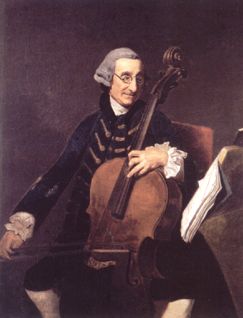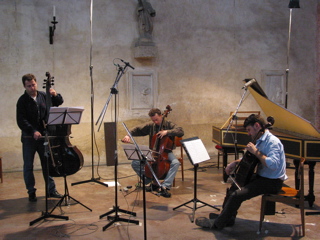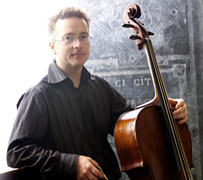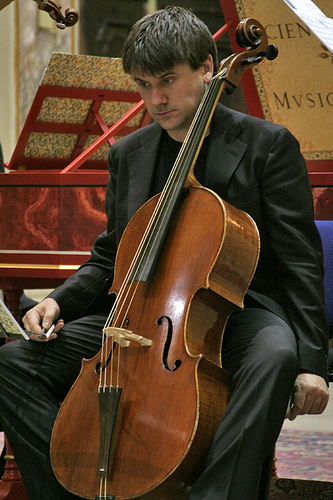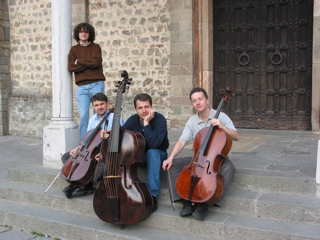|
|
Giacobo Basevi Cervetto (1681?-1783)
Six Sonatas for three Violoncellos
(Sei sonate o
trii per tre violoncelli e basso)
MVC/005-008 DDD on original instruments -
Registrazione ed Editing 24 bit 96 Khz
Testi libretto
- Booklet texts |
|
|
|
Sei sonate o trii per tre violoncelli o due violini e basso (Six Sonatas or Trios for three Violoncellos or two Violins and a Bass), recita il frontespizio dell’op. 1, pubblicata a Londra presso l’autore tra il 1741 e il 1745 circa. A un orecchio moderno suona curioso il fatto che i termini sonata e trio siano dati come sinonimi: di fatto il genere – sui cui in effetti regnava una grande confusione terminologica – è noto oggi più che altro con il nome di sonata a tre. Al più tardi a partire dalle composizioni di Corelli, perciò da circa quarant’anni all’epoca della pubblicazione di Cervetto, la sonata a tre era considerato il genere più importante nella musica da camera, e un vero banco di prova per i compositori. Il genere morì con la fine dell’epoca barocca, ma non senza essersi profondamente evoluto, avendo attraversato lo stile ‘galante’ e accogliendo le prime anticipazioni dello stile classico. Naturalmente i manuali di composizione facevano fatica ad accettare le innovazioni: in ambito tedesco, J.A.P. Schulz nel suo articolo sul Trio (in J.G. Sulzer, Allgemeine Theorie der schönen Künste, 1771-74) distingue un trio «proprio» e un trio «improprio» («eigentliches», «uneigentliches Trio»). J.J. Quantz nell’edizione 1789 del suo manuale per il flauto traverso (Versuch einer Anweisung, die Flöte traversière zu spielen) supera il giudizio di valore di Schulz, ma distingue ancora nettamente fra un trio «elaborato» e un trio «galante» («gearbeitet», «galant»), quando ormai il genere era praticamente estinto. La sonata tradizionale prevedeva uno stile imitativo (almeno nel motivo iniziale) in tutti i movimenti, solitamente quattro, e una netta distinzione tra le due voci superiori, affidate in genere a due violini, e l’accompagnamento del basso continuo. Al contrario, la sonata a tre moderna – quella che il teorico tedesco J.A. Scheibe chiamava nel 1745 «nella maniera da concerto», «auf concertenart» – prevedeva solo tre movimenti, riservava al secondo violino una semplice funzione di accompagnamento, e affidava la melodia al primo violino (e occasionalmente anche al basso, che prima fungeva quasi soltanto da supporto armonico).
E. van der Straeten considerava del tutto antiquate le composizioni di Cervetto, il che può valere in relazione alla letteratura per violoncello del 1914 – l’anno di pubblicazione della sua storia del violoncello –, ma non certamente a confronto con le composizioni della metà del Settecento. Tutte e sei le sonate di Cervetto hanno tre movimenti, e tranne la quarta tutte si concludono con un minuetto. Invece di sovrapporre polifonicamente la melodia iniziale, Cervetto la ripete per intero, presentandola prima in un violoncello, poi nell’altro (sonate 2, 4, 5). Quanto siano lontane le sue melodie dai temi del barocco più antico ci viene dimostrato ad esempio dalle qualità cantabili del secondo movimento della seconda sonata, o dell’inizio della terza sonata. In omaggio alla tradizione, Cervetto pone come ultima composizione della raccolta una sonata in modo minore i cui due primi movimenti iniziano in severa imitazione. Eccettuati questi due brani, soltanto il secondo movimento della quinta sonata è imitativo, ma che differenza rispetto alla sesta sonata! Qui l’imitazione è al servizio dell’espressività melodica (‘affetto’, si sarebbe detto all’epoca), sfruttando le sovrapposizioni delle voci e la lentezza del movimento. Pur senza uscire dai confini del loro paese, furono musicisti italiani come G.B. Sammartini, Pugnani e altri a favorire attraverso le proprie opere pubblicate sulle piazze editoriali di Parigi e Londra – ben più importanti di quelle italiane dell’epoca – la diffusione di un gusto moderno (vale a dire ‘galante’) negli anni 1730-1740. Lo stile moderno fu poi ripreso e diffuso a Londra da numerosi compositori: tra gli altri, J.Ch. Bach, Abel, Stamitz, Campioni e Cervetto stesso. Nell’ambiente musicale di per sé piuttosto conservatore della capitale inglese c’era quindi in realtà la presenza simultanea di stili diversi, e una grande libertà per i compositori nell’utilizzare liberamente elementi di varia provenienza. Proprio questa libertà nell’accostare elementi tradizionali ed elementi innovativi colpisce nella raccolta di Cervetto, e ne costituisce, insieme all’impasto timbrico dei violoncelli, il fascino principale.
Ricordando le prestazioni di Cervetto come concertista, si può facilmente immaginare che le sonate siano state composte per tre violoncelli, mentre l’alternativa di suonarle con due violini è probabilmente nata soltanto dal desiderio commerciale di renderle interessanti per un pubblico più vasto. Lo stesso desiderio si cela dietro l'organico del continuo ridotto al minimo (un terzo violoncello); l'organico alternativo con i violini indica un più generico "basso". In effetti la linea del basso è numerata, e riteniamo che la partecipazione di uno strumento a tastiera o a pizzico che realizzi le armonie sia più che giustificata. Abbiamo inoltre usato per il basso un violone 8 piedi, e in tre sonate anche un contrabbasso, per estendere lo spazio sonoro verso il grave. A prendere alla lettera il frontespizio, sarebbe possibile eseguire le sonate con tre violoncelli soltanto, cioè senza uno strumento a tastiera che realizzi l’accompagnamento del basso continuo. Non si tratta di un elemento necessariamente ‘moderno’: già le sonate per violino dell’op. 5 di Arcangelo Corelli erano «a violino e violone o cimbalo».
|
Six Sonatas or Trios for three Violoncellos or two Violins and a Bass, is the title of op. 1, published in London by the author between 1741 and 1745 circa. To the modern ear, it is curious to hear the terms sonata and trio referred to as synonyms: in fact, the genre – which in effect did experience a certain confusion regarding the terminology – is known today as the sonata a tre.
E.
van der Straeten considered the compositions of Cervetto to be out-dated,
perhaps a valid assessment when comparing them to the literature for violoncello
in 1914 – the year his history of the violoncello was published - but certainly
not with respect to the compositions of the mid-eighteenth century. All six of
Cervetto’s sonatas have three movements, and with the exception of the fourth,
conclude with a minuet. Instead of polyphonically superimposing the initial
melody, Cervetto repeats it in its entirety, introducing it for the first time
in one violoncello, then in the other (sonatas 2, 4, 5). The song-like quality
of the second movement of the second sonata and the beginning of the third
demonstrate how different his melodies are from the earliest baroque themes. In
homage to tradition, the last composition in the series is in a minor key in
which the first two movements of the sonata commence in strict imitation. Except
for these two pieces, only the second movement of the fifth sonata is imitative,
but what a difference with respect to the sixth sonata! Here the imitation is at
the service of the melodic expressiveness (‘affetto’ they would have said in
that period), taking advantage of the superimposed voices and the slowness of
the movement. Though they never left the borders of their country, Italian musicians such as G. B. Sammartini, Pugnani and others, fostered through their own works, published by editors in Paris and London – much more important than the Italian ones in that period – the diffusion of modern style ( referred to as ‘galante’) in the years 1730-40. The modern style was then taken up and spread to London by numerous composers: among them were J. Ch. Bach, Abel, Stamitz, Campioni, as well as Cervetto. Therefore the musical scene, in the rather conservative English capital, witnessed the simultaneous presence of different styles, and composers had the liberty to utilise elements from diverse origins. This freedom in which traditional and innovative elements are brought together is what is most striking about Cervetto’s compositions, and constitutes, together with the interwoven timbres of the violoncellos, its principle charm.
As Cervetto was a concert musician, it is not surprising that his sonatas were composed for three violoncellos; the alternative of playing them with two violins was probably dictated by commercial reasons in order to interest a vaster public. This may also explain the motive behind which the basso continuo is reduced to a minimum (a third violoncello); the alternative organico with violins indicates a more generous “basso”. In effect the bass line is numbered, and the addition of a keyboard or plucked instrument which realises the harmony more than justified. We have used a “violone 8 piede” for the basso, and in three sonatas, also a contrabass to extend the sonority towards the grave. Taking the title page literally would suggest the possibility of performing the sonatas with three violoncellos only, and without the use of keyboard accompaniment for the basso continuo. The use of additional instruments for the basso does not necessarily imply a more “modern” approach: Arcangelo Corelli’s sonatas for violin op. 5 were already scored for «a violino e violone o cimbalo». |
|
